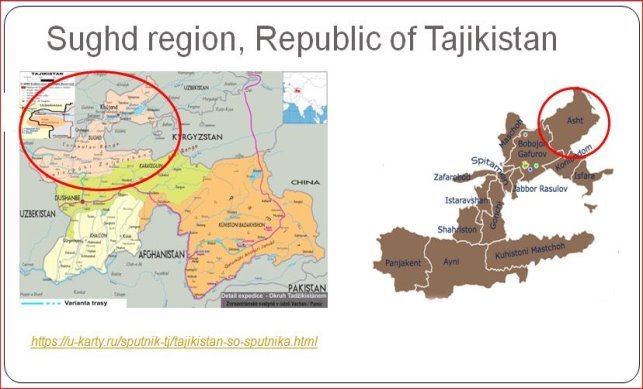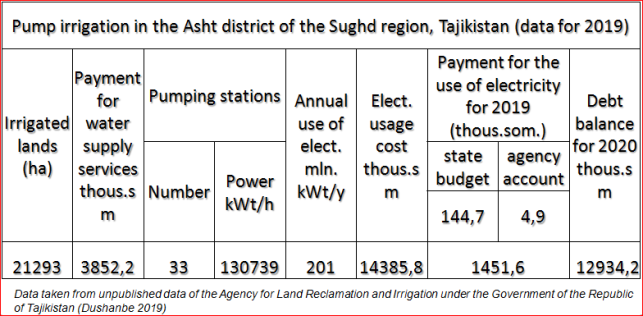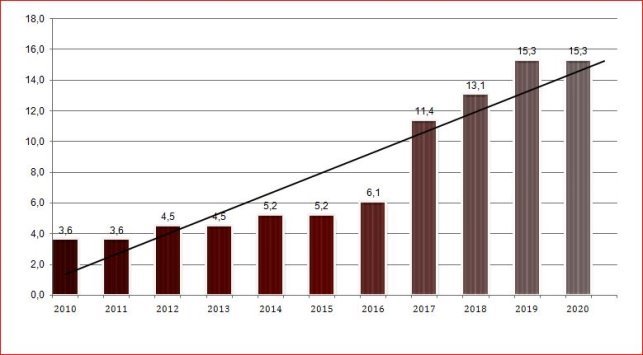This article will discuss the effectiveness of using pricing methods for the supply of irrigation water in the Republic of Tajikistan, using the example of Asht district, Sughd region, where a large number of pumps are used to irrigate arable land, including cascade ones, where the number of lifts reaches up to six. The article provides examples of the ineffectiveness of using traditional pricing methods and the features of the regulation of these methods and the transition to new economic conditions. Based on the fact that in 2019 the total area of land according to the State Committee for Land Management and Geodesy of the Republic of Tajikistan, arable land in Tajikistan amounted to 672682 hectares, and of this 381397 hectares (56.7 %) are irrigated by gravity and 291,285 hectares (43.3) with the help of pumps to irrigate this amount of land in total, 393 pumps were installed throughout the country, 337 of which were in working condition in 2019 (Data taken from unpublished materials of the Agency for Land Reclamation and Irrigation under the Government of the Republic of Tajikistan). Therefore, also taking into account increases in all other prices and costs that affect the cost of the resource itself, the transition to new efficient pricing is an integral part of the delivery of irrigation water.
Introduction
In the process of water use, as in other areas, there are several participants and stages. One is water suppliers, who may own wells or reservoirs, or have access and rights to water. Suppliers have time-dependent private costs of water delivery, and in order for this process to proceed without delays and for water in good quality and on time to reach water users, these costs need to be covered on time and in full (David Zilberman, 2005) [1]. Indeed, all over the world, most of the renewable resources of fresh water are used for irrigation. Since the demand for water increases with an increase in living standards and population growth, and also, since the prospects for water withdrawal (withdrawal) are limited in some regions and are absent in others, the course of water policy remains open — increasing the efficiency of water use. This requires taking into account the full cost of water, and the way this is achieved inevitably leads to some form of water pricing. However, water policymakers are far from agreeing with economists as to what constitutes the “right” price for water in any given circumstance and how that price should be charged.
In the past, most cities and utilities in the world provided water to their customers almost free of charge because water was considered a basic necessity and because water was relatively cheap in price and abundant in quantity. But now that much larger communities need services, the only way to ensure that everyone has access to this basic need is to ration it in some way. And perhaps the best way to use water for the best and most valuable purposes is to set the price of water and build appropriate tariff structures to achieve different social, political and economic goals in different situations (P. Rogers et al, 2002) [2]. As the notion that water is a scarce economic commodity is gaining ground. Consequently, the development of water pricing mechanisms is given high priority among various instruments for effective water management (Bjornlund and McKay, 1998) [3].
Since irrigated agriculture is the main consumer of water worldwide (Johansson et al., 2002) [4], the development of efficient pricing mechanisms for irrigation water is especially relevant for sustainable water management.
Despite the extensive and varied literature on irrigation water pricing (Boworth et al., 2002; Molle and Berkoff, 2007; Hellegers and Perry, 2004) [5,6,7], it remains a challenge to determine the “right” price or economic cost of irrigation water. Very often, tariffs do not even cover the full cost of delivery, and sometimes the cost of water is lower than the cost of delivery. But, and the fundamentals of economics require that the price of a service be at least the same as the cost of providing this service. Peter Rogers (1998) argued that sustainable and efficient use of water requires a tariff to match not only the costs of supplying water (operating, maintenance and capital costs), but also alternative costs such as economic, external and environmental costs. The recent World Water Commission strongly supported and agreed that the single most immediate and important action to be taken is the need to establish the full cost of water services and move towards a single price for water services (World Water Commission, 2000, p. 33) [8].
Thus, the only solution is integrated water resources management. Since when economic, legal and environmental aspects complement each other, then higher prices will increase the equity, efficiency and sustainability of the resource (P. Rogers et al, 2002) [2].
Location
Asht region (40 ° 45'N 70 ° 25'E) with an area of about 2800 km2 is the most extreme northern region of Tajikistan on the border with Uzbekistan. In this area, almost all land is irrigated using cascade pumps, where the largest has 6 rises. As of January 2020, the population of the district was about 168,000 people.
Table 1
Asht district, Sughd region, Tajikistan

Overview of currently used methods for water supply services in Tajikistan.
In the Republic of Tajikistan, the water management complex is the most important component of the national wealth, which is widely used in almost all spheres, but, like in other Central Asian countries, a large amount is used in irrigation.
In practice, the country uses two types of tariff determination for water withdrawals: one-rate and two-rate. The one-rate tariff is applied for production and communal needs not related to irrigation. The tariff is set for 1m3 of water supply at the point of water discharge. The two-part tariff provides for the establishment of payment for water supply for the needs of irrigation and watering on the basis of per hectare and per cubic meter rate.
The two-part tariff used in Tajikistan includes fees per hectare based on the crop irrigated.
Pumping irrigation in Asht region

In Asht region, a total of 33 pumps are used to irrigate 2,123 hectares of land, which in 2019 used about 200 million kilowatts of electricity worth about 15 million somoni (approximately $ 1 million). And the collection for water supply services amounted to about 4 million somoni (352 thousand dollars). If we compare these amounts, then the price for the use of electricity is 11 times higher than the collected volume of water supply. In addition, there are other costs such as employee salaries, fall / winter events, and other operating costs. Due to the fact that the debt of irrigation facilities is growing from year to year, the state since 2018 has decided to pay for most of the electricity consumed directly from the subsidy, but as a result, it excluded all operating costs from the budget.
For 2019, only 737,500 somoni ($ 64,665.11) were allocated from the state budget only for the payment of employee salaries and other mandatory payments. (Data taken from unpublished materials of the Agency for Land Reclamation and Irrigation under the Government of the Republic of Tajikistan). The collected funds of the Department of Land Reclamation and Irrigation itself for water supply services in 2019 amounted to 3,852,200 somoni ($ 337,766.67).
The distribution of this amount can be seen in table below.
Table 3
Income and expenses of funds for water supply services in the Department of Land Reclamation and Irrigation in Asht District
|
Income for 2019 Thous. |
Spending (thous.) | |||||
|
Salary |
Taxes |
Using of Electricity |
Carrying out autumn-winter works, purchasing equipment, etc. |
Other operating expenses | ||
|
som. |
3852,2 |
1516,2 |
181,4 |
47,9 |
2013,1 |
93,6 |
|
$ |
337,77 |
132,94 |
15,91 |
4,2 |
176,51 |
8,21 |
(Data taken from unpublished materials of the Agency for Land Reclamation and Irrigation under the Government of the Republic of Tajikistan)
The situation that was given on the example of the Department of Land Reclamation and Irrigation of Asht District (table 2) is not the only one, since we have already made a note above that almost half of the country's irrigated land is irrigated with the help of pumps and wells, and since the payment for electricity rises year after year (Table 4), the situation with payments for electricity is also getting worse.
Table 4
Increase in electricity over the past 10 years.

(Data taken from unpublished materials of the Agency for Land Reclamation and Irrigation under the Government of the Republic of Tajikistan)
This table shows data on the increase in electricity tariffs only for the last 10 years, which during this time increased by 5 times.
According to the Agency for Land Reclamation and Irrigation under the Government of the Republic of Tajikistan, in 2019 alone, the cost for the use of electricity by pumping stations throughout the country amounted to 107384300 somoni ($ 9415530.59). For the period of January 1, 2020, the debt of the melioration and irrigation departments for the use of electricity, taking into account the previous years, amounted to 211,750,000 somoni ($ 18,566,388.23). Unlike electricity prices, prices for water supply services increased only once during this period.
Table 5
Increase in prices for water supply services for water supply services
|
Payment for 1m³ |
Somoni |
$ (20/05/2021) |
|
|
Till may 2018 |
0,017 |
0,0015 | |
|
From 01.06.2018 |
0,02 |
0,0018 |
Order of the Antimonopoly Service under the Government of the Republic of Tajikistan from May 30, 2018, № 62
To dig deeper into the situation, Table 6 provides an example of fundraising for water services and electricity bills over the past three years.
Table 6
Comparative analysis of income for water supply services and payments for the use of electricity in pumping stations
|
Years |
Income from water supply services |
The cost of electricity used |
All paid |
Balance to 01.01 next year taking into account previous years | ||||
|
somoni |
$ (20.05.2021) |
somoni |
$ (20.05. 2021) |
state budget |
agent budget |
somoni |
$ (20.05. 2021) | |
|
2017 |
57071100 |
5004034 |
71980200 |
6311252,73 |
698000 |
1783900 |
15123900 |
1326069,6 |
|
2018 |
61385500 |
5382323,61 |
89442300 |
7842336,64 |
26025700 |
2281943,79 |
133950100 |
11744798,35 |
|
2019 |
65529500 |
5745672,43 |
107384200 |
9415489,61 |
31213100 |
192900 |
211750000 |
18566388,23 |
(Data taken from unpublished materials of the Agency for Land Reclamation and Irrigation under the Government of the Republic of Tajikistan)
From this table, it can be analyzed that in 2019 alone, about 99.4 % of the payment for the use of electricity was paid from the state budget and only 0.61 % from the budget of the departments themselves. Otherwise, if the entire amount for the use of electricity had to be paid by the very departments of land reclamation and irrigation, then the total annual fee for electricity would cover only 60 % (2019) of the annual use of electricity, not counting the debts for previous years.
On the one hand, this may seem very convenient, since almost all payment is made from the state budget, but if you dig deeper, then this situation began in 2017, when, due to large debts for the use of electricity, the state decided to cut the budget of the Land Reclamation Directorates and Irrigation Agency for Land Reclamation and Irrigation under the GRT, excluding salaries of civil servants and send this amount to pay for the use of electricity.
Conclusion and Recommendation
At the moment, the opinion of economists is inclined to believe that this method is more suitable in the conditions of Tajikistan, but at present there are some shortcomings in this method as well. At first glance, this is not bad, since the fee will be charged based on the economic cost of sowing, but if you take a closer look, you can understand that in this applied tariff, when determining water consumption limits, only biological irrigation norms of agricultural crops are taken as a basis, but in most cases, their effect on water erosion of soil, deterioration of the land reclamation state and loss of humus, etc., are not taken into account.
Based on the foregoing, we can confidently refer to the fact that year after year, new economic conditions oblige us to move all spheres and aspects in parallel in order to achieve comprehensive achievements and harmony. Consequently, changes in water pricing can improve economic efficiency and social equity, and, if fewer resources are used more efficiently, lead to better environmental conditions. Consequently, water prices will help solve all three problems related to resource sustainability issues that are relevant today.
But, despite all the existing studies, it has been shown that area pricing methods are used in more than 60 % of cases, while volumetric pricing is used in about 25 % of the cases studied (Bose and Walters, 1990) and they were more effective.
Summing up, we can say with confidence that in order to achieve the desired results, first of all, it is necessary to correctly formulate a water policy based on the nature of the property rights assigned to water in different countries. Only then can an equitable distribution of water resources and an increase in the sustainability of both the resource itself and the supply be achieved. The preferred pricing method is the one that provides the most benefit, including transaction costs. In cases where transaction costs are not high (in cases where the water is gravity), pricing per hectare can be used, but in other cases it is more efficient to use tiered methods. For example, in the absence of implementation costs, it would be efficient to use the volumetric method. Since the implementation costs associated with each pricing method vary greatly from region to region due to differences in climate, demographics, social structure, water rights, water bodies, history and general economic conditions, the net benefit associated with each method, the best option would be to vary from region to region.
References:
- David Zilberman and Karina Schoengold (2005) The Use of Pricing and Markets for Water Allocation, Canadian Water Resources Journal, Vol. 30(1): 47–54
- Peter Rogers, Radhika de Silva, Ramesh Bhatia (2002) Water is an economic good: How to use prices to promote equity, efficiency, and sustainability, Water Policy 4 (1–17).
- Bjornlund H. and McKay J. (1998) Factors affecting water prices in a rural water Market: a South Australian experience, Water Resource Research, 34, 1563–1570
- Johansson R. C., Tsur Y., Roe T. L., Doukkali R. and Dinar A. (2002) Pricing irrigation water: a review of theory and practice, Water Policy, 4, 173–199
- Boworth B., Cornish G., Perry C. and Van Steenbergen F. (2002) Water charging in irrigated agriculture: lessons from the literature. Report OD 145. HR Wallingford Ltd, Wallingford, UK.
- Molle F. and Berkoff J. (2007) Water pricing in irrigation: mapping the debate in the light of experience.
- Hellegers P. J. G.J. and Perry C. J. (2004) Water as an Economic Good in Irrigated Agriculture: Theory and Practice. Report 3.04.12. LEI-Wageningen UR: The Hague.
- World Water Commission, 2000
- State Committee for Land Management and Geodesy of the Republic of Tajikistan, Dushanbe 2019.
- Agency for Land Reclamation and Irrigation under the Government of the Republic of Tajikistan, Dushanbe.


